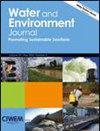Development of wastewater quality index as an assessment tool of treated wastewater quality for sea discharge
IF 1.8
4区 环境科学与生态学
Q4 ENVIRONMENTAL SCIENCES
引用次数: 0
Abstract
The evaluation of the effluent water quality from wastewater treatment plants is fundamental for human health and aquatic environment considerations. Therefore, this research presents a new and specific water quality index for evaluating the effluent water discharged into the sea by integrating the complex set of wastewater qualities into a single reliable value. Two approaches were utilized for this purpose: experts' opinions and statistical analysis using principal component analysis. In the first approach, the opinions of local experts shortlisted the parameters into six important parameters out of a list of 19 with assigned weights varied from 0.160 to 0.174. In the statistical approach, principal component analysis and correlation analysis reduced the parameters to seven accounting for 75% of the variation in the data. Their weights were calculated based on their eigenvalues and ranged from 0.063 to 0.435. The subindices rating curves were developed based on the Kingdom of Bahrain's legislated standards and the weighted arithmetic mean function was used for the aggregation stage. The established water quality indices were applied to effluents from a local wastewater treatment plant, and the obtained results revealed “Class 1: excellent category” discharge quality maintained throughout the year as per the categories proposed in this work. The developed indices proved their effectiveness and reliability in assessing the treated water. The study provides a comprehensive and reliable assessment of treated water quality, and its approach and outputs could have significant implications globally for ensuring the quality of treated water prior its discharge and promoting sustainable development.制定废水质量指标,作为评估经处理后排放入海的废水质量的工具
评估污水处理厂的出水水质对人类健康和水生环境至关重要。因此,本研究提出了一种新的特定水质指数,通过将一系列复杂的废水水质整合为一个可靠的值,来评估排放入海的废水水质。为此采用了两种方法:专家意见和利用主成分分析法进行统计分析。在第一种方法中,根据当地专家的意见,从 19 个参数中筛选出 6 个重要参数,权重介于 0.160 到 0.174 之间。在统计方法中,主成分分析和相关分析将参数减少到七个,占数据变化的 75%。这些参数的权重是根据其特征值计算得出的,权重范围为 0.063 至 0.435。子指数评级曲线是根据巴林王国的法定标准制定的,在汇总阶段使用了加权算术平均函数。所建立的水质指数适用于当地一家污水处理厂的出水,结果显示 "1 级:优秀类 "的排放水质全年保持在本工作所建议的类别中。开发的指标证明了其在评估处理水质方面的有效性和可靠性。这项研究提供了一种全面、可靠的污水处理水质评估方法,其方法和结果可在全球范围内对确保污水排放前的水质和促进可持续发展产生重要影响。
本文章由计算机程序翻译,如有差异,请以英文原文为准。
求助全文
约1分钟内获得全文
求助全文
来源期刊

Water and Environment Journal
环境科学-湖沼学
CiteScore
4.80
自引率
0.00%
发文量
67
审稿时长
18-36 weeks
期刊介绍:
Water and Environment Journal is an internationally recognised peer reviewed Journal for the dissemination of innovations and solutions focussed on enhancing water management best practice. Water and Environment Journal is available to over 12,000 institutions with a further 7,000 copies physically distributed to the Chartered Institution of Water and Environmental Management (CIWEM) membership, comprised of environment sector professionals based across the value chain (utilities, consultancy, technology suppliers, regulators, government and NGOs). As such, the journal provides a conduit between academics and practitioners. We therefore particularly encourage contributions focussed at the interface between academia and industry, which deliver industrially impactful applied research underpinned by scientific evidence. We are keen to attract papers on a broad range of subjects including:
-Water and wastewater treatment for agricultural, municipal and industrial applications
-Sludge treatment including processing, storage and management
-Water recycling
-Urban and stormwater management
-Integrated water management strategies
-Water infrastructure and distribution
-Climate change mitigation including management of impacts on agriculture, urban areas and infrastructure
 求助内容:
求助内容: 应助结果提醒方式:
应助结果提醒方式:


